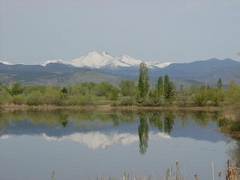
You cannot approach Longmont from the east without seeing the decaying sugar beet factory and its surroundings. Sugar was king around here in the early 1900's, and expensive "high tech" sugar factories dotted the map on the Front Range, and along the Platte River toward Nebraska. Like in Longmont, some of these factories still remain today, crumbling brick by brick. In an ongoing series, we'll visit some of the factories still standing, including the sole active one in Ft. Morgan. We'll get to Longmont's factory in a few blog entries from now, but first let's take a look at the Front Range's first sugar factory, in Loveland.
Much of the good information here comes from a free and extremely readable publication that is available online (in PDF format) , called "Silver Wedge: The Sugar Beet Industry in Ft. Collins". Don't let the title fool you - this is a complete story of the sugar beet in Colorado, including sections that describe planting to production, Front Range agricultural conditions, labor, competition, financial investment, government intervention, and the eventual downfall of beet sugar.
It took a while for the US sugar beet industry to find the Front Range and eastern plains, first trying in places like Michigan, Utah, Nebraska, California, and the Grand Junction and Rocky Ford areas of Colorado. The Front Range had the ideal characteristics for sugar beet growing: water (obtained mostly through irrigation) but helped in the early growing season by the typical May rain, plenty of sunshine, loam soil, which holds in the mineral content instead of letting it leach away, and a dry climate which helped keep away pests. Beets grown experimentally on the Front Range were consistently showing that they contained a world-class 15% sugar, which caught the Department of Agriculture's attention, as well as the investment community.
Loveland's sugar factory was built by the Great Western Sugar Company and opened in 1901. It has been called the "mother" sugar factory of the Front Range. Even though it had a very poor first year, due to factory and farmer inexperience, it set the investment gears in motion to fund other factories as it became successful and filled to capacity. In 1902, the Loveland factory had contracted with 12,000 acres of beets, which was near all it could handle. In a good year of growing, an acre could produce 15 tons of beets!
The Loveland Sugar Factory today, from the south. It was closed in 1985, giving it a lifetime of 81 years:

Why did beet sugar in Colorado mostly fade away? The common reasons I've read are competition from cheaper cane sugar abroad, and other sweeteners such as corn syrup. It was interesting to see that the US sugar industry was mentioned by President-elect Obama during the campaign.
Most every Colorado sugar factory (as you'll see in future entries), had an administration building up front. In one redevelopment plan for this area that eventually didn't work out, the Loveland administration building (below) was slated to be restored.

An iron pipe, very likely from inside the factory, is now used as an outside boundary marker along Madison Street:


Trains were used heavily to transport beets to the factory. The old railroad bed on the right of the picture below shows how the factories used an elevated track which permitted gravity to be used to unload the beets from the cars.


An old sign, advertising a 50 cent (vintage!) brick sale from the factory:


The Pennsylvania connection: This piece of rail section says "Carnegie 1909" on it (very neat to see this on the first day of 2009!), while another piece of rail gear appears to be made by Bethlehem Steel:


Amalgamated Sugar is the current property owner:


Another common theme for most all of the shuttered Colorado sugar beet factories is trespassing and vandalism:

For a cool $1.25 million, you can apparently purchase the sugar factory site in Loveland.

 One citizen's view of Longmont, Colorado, USA.
One citizen's view of Longmont, Colorado, USA.

5 comments:
Thanks!
A good book I have found that goes more into detail on the steam trains used by GW surgar and detaied maps and factory info look up. Sugar Tramp. Auther I don't know I will look for the book and get back with you.
When I was a younger fellow, I remember the factory in operation. It had a pungent smell that was very memorable. It's interesting how degenerated it looks now when it doesn't seem like it's been out of operation for an extremely long time. A bit sad I guess.
I had explored this factory just a day before the molasses tank burst, I walked right by the tank.
my family worked there was wondering where the original documents of workers were. His name was Emil Adolph Anderson
@rinstar Colorado State University was bequeathed the records of Great Western, which included info about personnel.
You should be able to get in touch with the contact listed here: http://lib.colostate.edu/archives/greatwestern/
Good luck,
Peter
Post a Comment